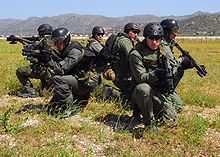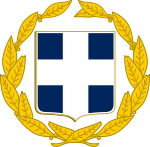Underwater Demolition Command
| Underwater Demolition Command Διοίκηση Υποβρυχίων Καταστροφών (ΔΥΚ) | |
|---|---|
|
Underwater Demolition Command (DYK) emblem | |
| Active | 1957–Present |
| Country |
|
| Branch |
|
| Type | Special Forces |
| Role |
|
| Part of |
Naval Training Command (Greek: Διοίκηση Ναυτικής Εκπαίδευσης (ΔΝΕ)) |
| Nickname | |
| Website | Underwater Demolition Command |
| Commanders | |
| First | Captain Konstantinos Egkolfopoulos |
| Insignia | |
| Abbreviation | Δ.Υ.Κ. |

The Underwater Demolition Command (Greek: Διοίκηση Υποβρυχίων Καταστροφών), abbreviated as DYK (Greek: ΔYK,Greek pronunciation: [ðik]), until 2002 known as the Underwater Demolition Unit (Greek: Μονάδα Υποβρυχίων Καταστροφών), abbreviated as MYK (Greek: ΜYK,Greek pronunciation: [mik]), is the Greek Navy's elite special warfare unit.
History
Carrying on the tradition of the Hellenic Navy in naval special operations, the unit was established in 1957 with help from the United States Navy's Underwater Demolition Team, when two Greek officers were sent to Little Creek in Virginia to study UDT operations. On their return, they trained a dozen men who formed the nucleus of the MYK cadre. The OYK has been deployed on numerous occasions. It was deployed during the first Gulf War in 1991, providing assistance for the naval embargo against Saddam Hussein, boarding 217 suspect vessels. In 1996, the OYK was involved in the Imia crisis when Turkish commandos infiltrated the island. Small OYK teams infiltrated surrounding islands to observe activities, pending a political solution to the crisis and withdrawal of Turkish forces. In 1997, during the violent unrest that erupted in neighbouring Albania, the OYK were responsible for taking control of the international airport of Tirana and the evacuation of 240 foreign dignitaries from Albania (Operation Kosmas).[1]
Structure
The OYK is organised into subsections called Underwater Demolition Teams (Greek: Ομάδες Υποβρυχίων Καταστροφών), commonly known in their abbreviated form as OYK (Greek: ΟΥΚ,Greek pronunciation: [oik]), that specialise in a particular area. Each subsection consists of 25 men split into five teams of five.
OYK 1/2: This is the main offensive section of the OYK that specialises in sabotage, raids and maritime counter-terrorism.
OYK 3: This section specialises in reconnaissance. Establishing and reconnoitering beach landing sites prior to a main amphibious assault.
OYK 4: The section specialises in underwater demolition/EOD of obstacles that may prevent an amphibious landing.
OYK 5: This section is a reserve section that is only activated in times of war or serious emergency. It is made up of reservists from the MYK and instructors from the main body.
The selection and training course lasts roughly seven months and is divided into three phases similar to that of the US Navy SEALs BUD/S course. The course has an extremely high failure rate similar to that of its US counterparts. The candidates will go on to airborne school and then continue to learn advanced naval special warfare techniques.
2015 Independece Day Parade Controversy
The OYK generated controversy at the Greek Independence Day parade of 2015, when it chanted a nationalistic refrain: «Και το όνειρο μας είναι / στην Πόλη εμείς να μπούμε / σημαία να υψώσουμε / τον ύμνο εμείς να πούμε», roughly translated as 'Our dream is to enter the City (Constantinople) to raise our flag and sing our anthem'. Opposition ministers from the PASOK party launched attacks on the defence Minister Panos Kammenos, accusing him of mishandling matters of vital foreign policy. Concerns were also expressed by the government (SYRIZA) MP Vassiliki Katrouvanou, who called the chants 'a clear offense to our republic', and highlighted the ongoing need to remove certain far-right elements from the Greek armed forces.[2]
See also
- Zeta Amphibious Raider Squadron (Z' MAK) (at 1st Raider/Paratrooper Brigade (Greece)#Structure)
References
External links
| |||||||||||||||||||||||||||||||||

